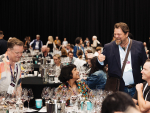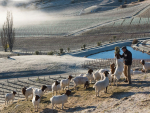Why he is so linked to our wine industry though is something that at times gets forgotten.
Born in Austria-Hungary, Bragato studied viticulture and oenology in Italy, and arrived in the Southern Hemisphere at the age of 31 as the Government viticulturist in Victoria, Australia.
In 1895 the Australians allowed him to travel to New Zealand, where the newly formed Department of Agriculture was interested in putting his skills to the test. They wanted to know if there were areas within New Zealand that would be suitable for winegrowing, where they were and how any potential industry should be formed.
Ironically his first port of call was probably the least likely place in the country for wine – Bluff. Oysters yes – but grape growing – unlikely.
However Bragato quickly moved north, was impressed by the Central Otago region and also Nelson. Interestingly he had nothing to say about Marlborough.
Within seven months he had produced a report – Prospects of Viticulture in New Zealand and after presenting it to the premier, he headed back to Australia.
That report, penned nearly 125 years ago provided an astute blueprint of how this country should go about developing a wine industry. It highlighted areas where viticulture could flourish and provided details of how the Department of Agriculture should go about it. Regional associations should be formed so “each district would determine the most suitable varieties for planting, collect and spread local data and this in great measure secure the industry against failure. Each district would subsequently gain notoriety for the wine produced as in the famous districts of the Continent.”
While there was initially great excitement, much of Bragato’s report, including suggestions that phylloxera resistant rootstock should be imported, was not acted on. When the Auckland vineyards began to be decimated by the very thing he had warned about, Bragato was asked to come back to New Zealand, this time as the head of a viticultural research base that had been established at Te Kauwhata. He quickly began establishing a vineyard at the station, where all the vines were grafted onto resistant rootstock. He held field days for those interested in learning more about grape growing. He even wrote a guide to viticulture booklet. Way ahead of its time, it defined which varieties would do well in which region, how to graft European varieties onto the resistant root stock, the best way to plant a vineyard, how to prune effectively and how to deal with potential diseases.
Utilising the fruit from the experimental vineyard, he also made wine that was beyond anything else produced in New Zealand at that stage. Five of those wines went on to win medals at the Franco-British wine exhibition, proving beyond doubt that New Zealand could produce a world-class product.
Initially the enthusiasm of Bragato was matched by that of the Government – until the temperance movement began to grow. As it grew, support for a wine industry in New Zealand waned. By 1909 Bragato had had enough and left for Canada.
That may have been the last we heard of him, if it hadn’t been for the resurfacing of his viticulture handbook 40 years ago. Much of what he had written in 1895 and 1906 was still relevant decades later. Following the advice from so many years ago has allowed the New Zealand wine industry to establish itself on the world stage.
Hence the reason we celebrate Romeo Bragato, the father of New Zealand
wine, with the annual wine industry conference. ν












